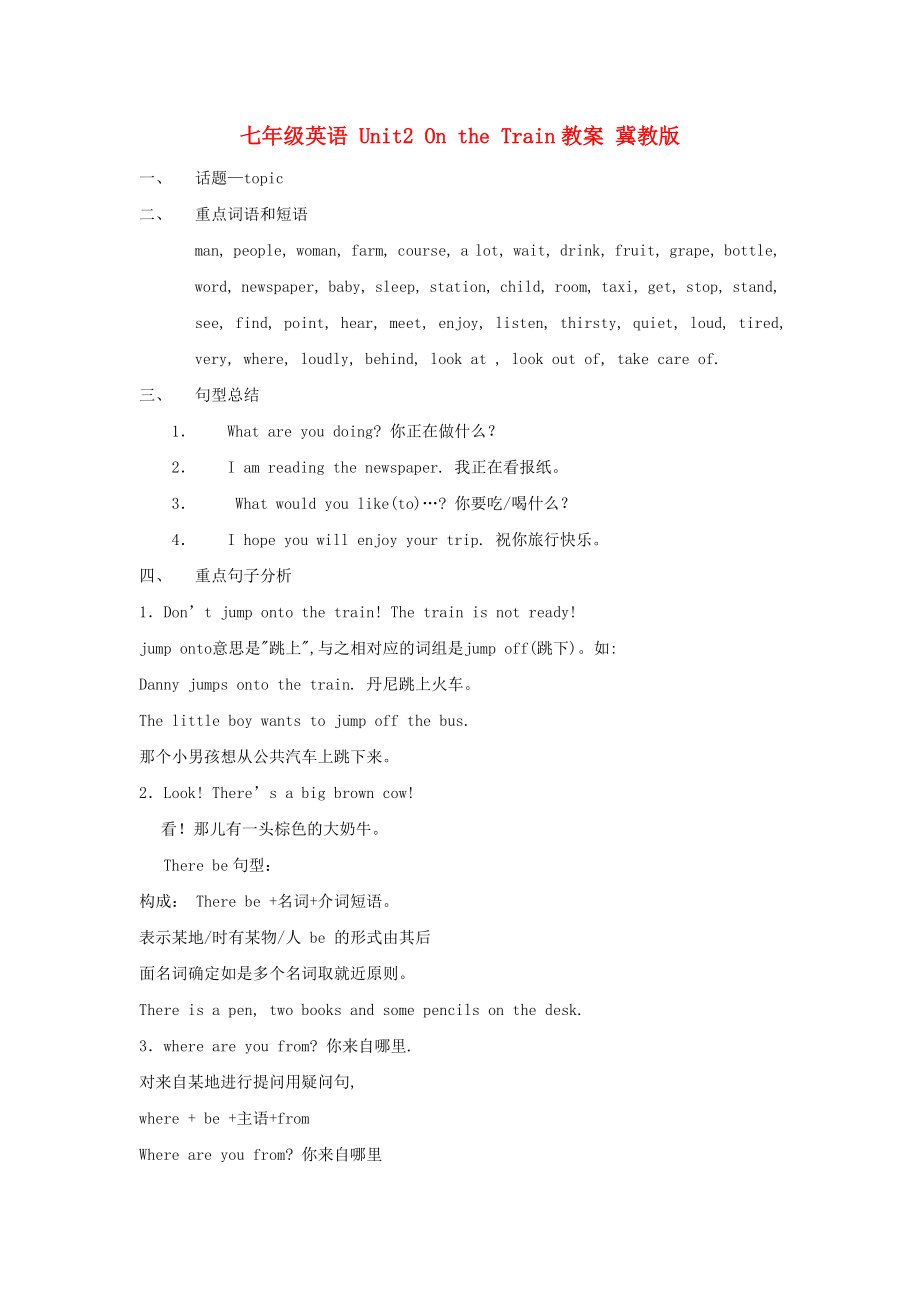《七年級(jí)英語(yǔ) Unit2 On the Train教案 冀教版》由會(huì)員分享����,可在線閱讀,更多相關(guān)《七年級(jí)英語(yǔ) Unit2 On the Train教案 冀教版(3頁(yè)珍藏版)》請(qǐng)?jiān)谘b配圖網(wǎng)上搜索���。
1���、七年級(jí)英語(yǔ) Unit2 On the Train教案 冀教版
一、 話題—topic
二��、 重點(diǎn)詞語(yǔ)和短語(yǔ)
man, people, woman, farm, course, a lot, wait, drink, fruit, grape, bottle, word, newspaper, baby, sleep, station, child, room, taxi, get, stop, stand, see, find, point, hear, meet, enjoy, listen, thirsty, quiet, loud, tired, very, where, loud
2��、ly, behind, look at , look out of, take care of.
三��、 句型總結(jié)
1. What are you doing? 你正在做什么�?
2. I am reading the newspaper. 我正在看報(bào)紙。
3. What would you like(to)…? 你要吃/喝什么�?
4. I hope you will enjoy your trip. 祝你旅行快樂(lè)。
四��、 重點(diǎn)句子分析
1.Don’t jump onto the train! The train is not ready!
jump onto意思是"跳上",與之
3�、相對(duì)應(yīng)的詞組是jump off(跳下)。如:
Danny jumps onto the train. 丹尼跳上火車(chē)�。
The little boy wants to jump off the bus.
那個(gè)小男孩想從公共汽車(chē)上跳下來(lái)。
2.Look! There’s a big brown cow!
看���!那兒有一頭棕色的大奶牛�。
There be句型:
構(gòu)成: There be +名詞+介詞短語(yǔ)。
表示某地/時(shí)有某物/人 be 的形式由其后
面名詞確定如是多個(gè)名詞取就近原則���。
There is a pen, two books and some pencils on
4�、 the desk.
3.where are you from? 你來(lái)自哪里.
對(duì)來(lái)自某地進(jìn)行提問(wèn)用疑問(wèn)句,
where + be +主語(yǔ)+from
Where are you from? 你來(lái)自哪里
I’m from Baoding. 我來(lái)自保定.
4. I would like a bottle of tea.
我想要一杯茶.
五.交際用語(yǔ)
就餐
Would you like a cup of tea? 你想要杯茶嗎���?
Yes, please./ No, thank you. 是的/ 不,謝謝
Would you like something to ea
5�����、t/drink? 你想要吃/喝點(diǎn)什么嗎��?
Yes, please./ No, thanks. 是的/不謝謝
What would you like to drink/eat?你要喝/吃些什么��?
I’d like (to have)some bread, please. 請(qǐng)來(lái)些茶/吃些面包
(或Some tea/ bread, please.請(qǐng)來(lái)些茶/面包�����。)
六.語(yǔ)法在線
可數(shù)名詞與不可數(shù)名詞
可數(shù)名詞:可以用數(shù)目計(jì)算,有復(fù)數(shù)形式
不可數(shù)名詞:一般無(wú)法用數(shù)目計(jì)算,無(wú)復(fù)數(shù)形式且不可用有定冠詞a ,an來(lái)修飾.
可數(shù)名詞變復(fù)數(shù)
(1)規(guī)則變化
1.一般情況下加”
6�、S” 如 book—books (書(shū))
2.以輔音字母+y 結(jié)尾,變y為 i 加es.
city---cities (城市) country ---countries (國(guó)家)
3.以 f 或fe結(jié)尾變f 或fe為v,再加es.
leaf—leaves(樹(shù)葉) knife---knives(小刀)
(2)不規(guī)則變化
1. 元音字母發(fā)生變化. man—men (男人)
foot—feet (腳)
2.詞尾發(fā)生變化. child—children (小孩)
3.單復(fù)數(shù)同形. sheep– sheep ( 綿羊)
7、4.形為單數(shù),實(shí)為復(fù)數(shù)意義.
people 人們
現(xiàn)在進(jìn)行時(shí)
1.用法:表示說(shuō)話時(shí)正在進(jìn)行的動(dòng)作
2.構(gòu)成:助動(dòng)詞am/is/are+動(dòng)詞的現(xiàn)在分詞
3.常與此時(shí)態(tài)相連的時(shí)間狀語(yǔ):now, these days等等. “ look! listen”等開(kāi)頭的祈使句,其后面的句子也常用現(xiàn)在進(jìn)行時(shí).
I’m reading a book now. 現(xiàn)在我正在看書(shū).
They’re ing soon.他們很快過(guò)來(lái).
Listen! Who is singing. 聽(tīng)!誰(shuí)在唱歌?
4.特殊疑問(wèn)句形式:由疑問(wèn)詞+be+主語(yǔ)+doing形式.
一般疑問(wèn)句形式:由“助動(dòng)詞be( am is are)+主語(yǔ)+doing 形式.
否定句形式:主語(yǔ)+be+not+動(dòng)詞的ing形式.
(1) What are you doing? 你正在干什么?
(2)Are you listening radio? 你正在聽(tīng)收音機(jī)嗎?
 七年級(jí)英語(yǔ) Unit2 On the Train教案 冀教版
七年級(jí)英語(yǔ) Unit2 On the Train教案 冀教版

